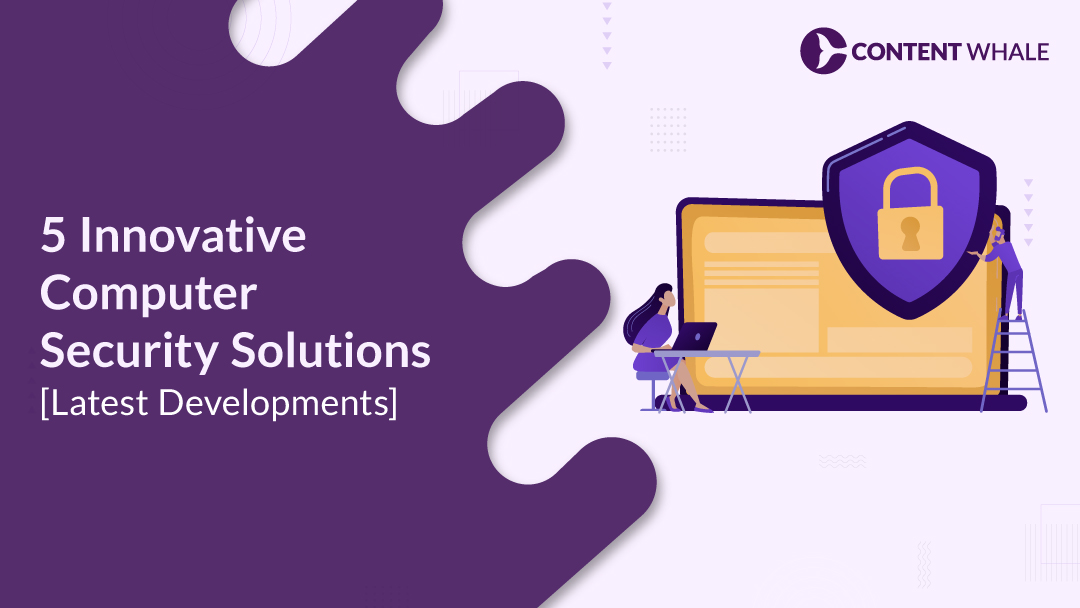Cybersecurity threats continue to grow in complexity, demanding innovative computer security solutions to protect sensitive data. With attackers constantly refining their techniques, it’s clear that traditional methods aren’t always enough to keep up. Companies now rely on cutting-edge technologies to stay ahead of cyber risks. The latest computer security trends show a shift toward more advanced tools like AI-driven threat detection and quantum cryptography. This blog explores five of the most advanced security technologies, offering insights into cybersecurity developments that are shaping the future and helping businesses strengthen their defenses in 2024.
1. AI-Powered Threat Detection and Response
Artificial intelligence (AI) has become a game-changer in cybersecurity, offering innovative computer security solutions that are faster and more efficient than traditional methods. With the ability to process massive amounts of data in real-time, AI-driven systems can detect and respond to threats almost instantaneously. Here’s how AI is reshaping cybersecurity developments:
a) Real-Time Threat Detection
- AI excels at recognizing patterns in data, making it highly effective at identifying anomalies that signal potential security breaches.
- Traditional systems rely on pre-defined rules, which may not detect new or evolving threats.
- AI, however, uses machine learning to learn from past attacks, improving its ability to spot irregular activity over time.
b) Automated Response
- Speed is essential in preventing the spread of an attack. AI-powered tools can automate responses, immediately neutralizing threats without waiting for human intervention.
- This reduces the risk of widespread damage, especially when dealing with large-scale attacks.
c) Predictive Capabilities
- One of AI’s most valuable features is its ability to predict future threats based on historical data.
- By continuously monitoring network activity, AI can forecast potential vulnerabilities and help businesses shore up their defenses before an attack occurs.
- This proactive approach aligns with latest computer security trends, where prevention is becoming as important as real-time detection.
d) Enhanced Accuracy
- Human error is a major factor in security breaches. AI mitigates this risk by analyzing data with greater accuracy and consistency.
- It can sift through vast volumes of information quickly, flagging potential risks that might otherwise go unnoticed.
AI-powered advanced security technologies are leading the charge in cybersecurity by making systems smarter, faster, and more reliable. As cyberattacks become more sophisticated, AI’s role in defending against them will continue to expand, making it one of the most innovative computer security solutions available today.
2. Zero Trust Architecture
Zero Trust Architecture (ZTA) is emerging as one of the most innovative computer security solutions, offering a significant shift from traditional security models. It focuses on the principle of “never trust, always verify,” ensuring that no user or device is inherently trusted, regardless of their location or network access. Here’s how Zero Trust is shaping cybersecurity developments:
a) Continuous Authentication
- Zero Trust requires every user or device to continuously prove their identity before accessing resources.
- This contrasts with older models where users inside the network were automatically trusted after initial login.
- By constantly authenticating every request, Zero Trust reduces the risk of compromised credentials leading to unauthorized access.
b) Micro-Segmentation
- Micro-segmentation is a core feature of Zero Trust, dividing networks into smaller, isolated zones. Each zone operates independently, requiring specific permissions to access.
- This makes it difficult for attackers to move laterally through a network if they manage to breach one area.
- With this approach, Zero Trust prevents the spread of attacks, a key defense against sophisticated threats.
c) Protection Against Insider Threats
- Traditional security systems primarily focus on external threats, often leaving organizations vulnerable to insider attacks.
- Zero Trust addresses this gap by treating every user, internal or external, with the same level of scrutiny.
- Even employees and contractors must verify their identity and authorization at every step, making it harder for malicious insiders to access sensitive data.
d) Enhanced Security for Remote Work
- With the increase in remote and hybrid work models, Zero Trust provides a robust solution for securing decentralized networks.
- Employees accessing company systems from different locations and devices pose security risks, but Zero Trust ensures that every access point is verified, reducing vulnerabilities.
- This feature has made Zero Trust one of the latest computer security trends for securing distributed work environments.
| Feature | Description |
| AI-Powered Threat Detection | Detects and responds to threats in real-time |
| Zero Trust Architecture | Requires continuous authentication |
| Quantum Cryptography | Provides unbreakable encryption |
| Cloud Security Posture Management (CSPM) | Automates cloud security monitoring |
3. Quantum Cryptography
Quantum cryptography is rapidly emerging as one of the most innovative computer security solutions, providing a new level of protection against modern cyber threats. With traditional encryption methods facing potential vulnerabilities, quantum cryptography offers an unbreakable solution. Here’s a breakdown of how it works and why it’s shaping cybersecurity developments:
Key Features of Quantum Cryptography:
a) Unbreakable Encryption
- Quantum Key Distribution (QKD) is at the core of quantum cryptography.
- Encryption keys are transmitted using quantum particles (like photons), which cannot be intercepted without detection.
- Any attempt to intercept the key causes an immediate alert, making the data virtually impossible to hack.
b) Future-Proof Security
- Quantum computing poses a threat to current encryption standards, as its processing power could break traditional algorithms.
- Quantum cryptography, however, is resistant even to quantum computing’s capabilities, ensuring long-term data security.
- This makes it a key focus in latest computer security trends, particularly for sectors that handle highly sensitive data.
c) Securing Communications
- Quantum cryptography protects not only stored data but also data in transit.
- It ensures secure, confidential communications over public and private networks.
- This level of security is vital for industries like healthcare, finance, and defense, where data breaches can have severe consequences.
d) Real-World Applications
- While quantum cryptography is still in its developmental stages, industries such as finance, telecommunications, and defense are already exploring its potential.
- As the technology matures, it is expected to become a critical part of advanced security technologies, offering a robust solution for future data protection.
4. Cloud Security Posture Management
With the growing shift to cloud computing, businesses face new security challenges. Cloud Security Posture Management (CSPM) has emerged as one of the most innovative computer security solutions to address these concerns. As organizations increasingly rely on cloud infrastructure, keeping these environments secure is essential. Here’s how CSPM is making a difference in cybersecurity developments:
a) Continuous Monitoring and Automation
- CSPM tools continuously monitor cloud environments for vulnerabilities, misconfigurations, and security gaps. This automation ensures that potential issues are identified and resolved before they become serious threats.
- These tools provide real-time alerts, enabling businesses to respond quickly to security issues.
b) Compliance Management
- One of the significant features of CSPM is its ability to ensure compliance with industry standards and regulations (such as GDPR, HIPAA, etc.).
- CSPM tools automatically check cloud environments against compliance requirements, helping companies avoid costly fines and legal issues.
- Keeping up with the latest computer security trends, CSPM integrates compliance checks directly into the system, ensuring continuous adherence to legal standards.
c) Identifying Misconfigurations
- Misconfigurations are one of the leading causes of data breaches in cloud environments. CSPM tools automatically scan for these vulnerabilities and help companies rectify them.
- CSPM reduces the risk of human error, a common issue in manually configured cloud environments.
d) Unified Security for Multi-Cloud
- Many businesses operate across multiple cloud platforms like AWS, Google Cloud, and Microsoft Azure. CSPM tools offer a unified view of security across all these platforms.
- This centralized management simplifies the security process and ensures that no cloud environment is overlooked, making it a key part of advanced security technologies.
| Security Tool | Key Features and Benefits |
| Bitdefender Total Security | Comprehensive protection with VPN, anti-phishing, ransomware protection, and low impact on system performance. |
| Norton 360 Deluxe | Dark web monitoring, parental controls, integrated VPN, and secure cloud backup for up to five devices. |
| McAfee Total Protection | Identity theft protection, encrypted storage, secure VPN, and multi-device coverage. |
| Avast One | Comprehensive web protection, ransomware defense, and unlimited VPN for up to 30 devices. |
| Kaspersky Total Security | Online payment protection, password manager, parental controls, and encryption tools for extra data security. |
Conclusion
Staying ahead of cyber threats requires embracing innovative computer security solutions that adapt to the complexity of modern cyberattacks. The latest computer security trends demonstrate a shift towards advanced security technologies like AI-powered threat detection, Zero Trust Architecture, quantum cryptography, and Cloud Security Posture Management (CSPM).
These cybersecurity developments provide the robust protection businesses need to defend their data and infrastructure. As threats continue to evolve, adopting these advanced technologies is essential for any organization looking to secure its future. Implementing these solutions helps ensure that sensitive information remains protected from increasingly sophisticated cyberattacks.
____
This blog is written by Content Whale to showcase our expertise in crafting content that ranks. If you’re looking to dominate your industry through high-quality, SEO-optimized content, just like we do, contact us today and let us help you achieve your ranking goals.
FAQs
1. What is the Zero Trust security model, and why is it important?
The Zero Trust security model is one of the most innovative computer security solutions, focusing on the principle of “never trust, always verify.” It requires continuous verification of user identities and devices at every access point, regardless of whether they are inside or outside the network. This approach helps prevent insider threats and reduces the risk of breaches, especially in remote work environments, aligning with cybersecurity developments in 2024.
2. How does AI enhance cybersecurity threat detection?
AI enhances threat detection by processing vast amounts of data in real-time, identifying anomalies, and predicting potential attacks. It plays a key role in advanced security technologies, reducing response times and improving accuracy. By learning from past incidents, AI systems continuously improve their ability to detect new and unknown threats. This automation allows businesses to mitigate risks quickly, making AI one of the latest computer security trends in 2024.
3. What is quantum cryptography, and how does it work?
Quantum cryptography is an encryption method that uses the principles of quantum mechanics to secure communication. By transmitting encryption keys through quantum particles, any attempt to intercept the key is instantly detected. This makes quantum cryptography one of the most innovative computer security solutions for safeguarding sensitive data. It’s a vital defense against the future threats posed by quantum computing, which could break traditional encryption.
4. Why is Cloud Security Posture Management (CSPM) essential for businesses in 2024?
With the rise of cloud computing, Cloud Security Posture Management (CSPM) tools have become essential for securing cloud environments. CSPM automates the detection of misconfigurations, ensuring continuous compliance with industry standards. As businesses expand their cloud operations, CSPM is a key part of cybersecurity developments, helping organizations protect their data in real time and manage cloud-based risks effectively.





